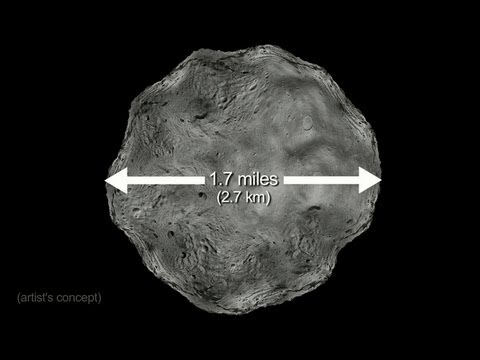more at
Radar astronomy shows that Asteroid 1998 QE2 has a moon.
Two NASA-JPL videos joined together:
1) “When Asteroid 1998 QE2 makes its closest approach to Earth on May 31, 2013, it promises to be a bonanza for radar science.”
2) Asteroid 1998 QE2 is shown to have a moon orbiting it. “Radar data of asteroid 1998 QE2 obtained on May 29, 2013.”
Public domain films from NASA-Jet Propulsion Laboratory.
(285263) 1998 QE2 is a near-Earth asteroid 2.75 kilometers (1.71 mi) in diameter. It was discovered on August 19, 1998, by the Lincoln Near Earth Asteroid Research (LINEAR) program located near Socorro, New Mexico. 1998 QE2 has an observation arc of 14 years and a well-determined orbit.
Characteristics
The surface of 1998 QE2 is covered with a sooty substance, suggesting that it might have previously been a comet that experienced a close encounter with the Sun. However, the Tisserand parameter with respect to Jupiter (TJ=3.2) does not make it obvious whether 1998 QE2 was ever a comet. The asteroid is optically dark with an albedo of 0.06 (meaning it absorbs 94% of light that hits it). As an Amor asteroid, the orbit of 1998 QE2 is entirely beyond Earth’s orbit. The Earth minimum orbit intersection distance (E-MOID) with the orbit of the asteroid is 0.035 AU (5,200,000 km; 3,300,000 mi). The asteroid has an orbital period of 3.77 years.
Satellite
Goldstone radar observations on May 29, 2013 discovered that 1998 QE2 is orbited by a minor-planet moon roughly 600 meters (2,000 ft) in diameter. In radar images, the satellite appears brighter than 1998 QE2 because it is rotating significantly more slowly, which compresses the radar return of the satellite along the Doppler axis. This makes the satellite appear narrow and bright compared to 1998 QE2. Once the satellite’s orbit is well determined, astronomers and astrophysicists will be able to determine the mass and density of 1998 QE2.
Earth approaches
On May 31, 2013, 1998 QE2 approached within 0.039 AU (5,800,000 km; 3,600,000 mi) (15 lunar distances) of Earth at 20:59 UT (4:59 pm EDT). This was the closest approach the asteroid will make to Earth for at least the next two centuries. It will be a very strong radar target at Goldstone from May 30 to June 9 and Arecibo from June 6 to June 12. At its closest approach the asteroid had an apparent magnitude of 11 and therefore required a small telescope to be seen.
Integrating the orbital solution shows the asteroid passed 0.08 AU (12,000,000 km; 7,400,000 mi) from Earth on June 8, 1975, with an apparent magnitude of about 13.9. The next notable close approach will be May 27, 2221, when the asteroid will pass Earth at a distance of 0.038 AU (5,700,000 km; 3,500,000 mi)…
The Goldstone Deep Space Communications Complex (GDSCC), commonly called the Goldstone Observatory, is located in the U.S. state of California’s Mojave Desert. Operated for the Jet Propulsion Laboratory, its main purpose is to track and communicate with space missions. It is named after Goldstone, California, a nearby gold-mining ghost town…
Goldstone antennas have also been used as sensitive radio telescopes for such scientific investigations as mapping quasars and other celestial radio sources; radar mapping planets, the Moon, comets and asteroids; spotting comets and asteroids with the potential to strike Earth; and the search for ultra-high energy neutrino interactions in the moon by using large-aperture radio antennas…
The Arecibo Observatory is a radio telescope in the municipality of Arecibo, Puerto Rico, USA. This observatory is operated by SRI International, USRA and UMET, under cooperative agreement with the National Science Foundation (NSF). This observatory is also called the National Astronomy and Ionosphere Center, although “NAIC” refers to both the observatory and the staff that operates it.
The observatory’s 1,000 ft (305 m) radio telescope is the world’s largest single-aperture telescope. It is used in three major areas of research: radio astronomy, aeronomy, and radar astronomy observations of the larger objects of the Solar System. Scientists who want to use the telescope submit proposals that are evaluated by an independent scientific board…

